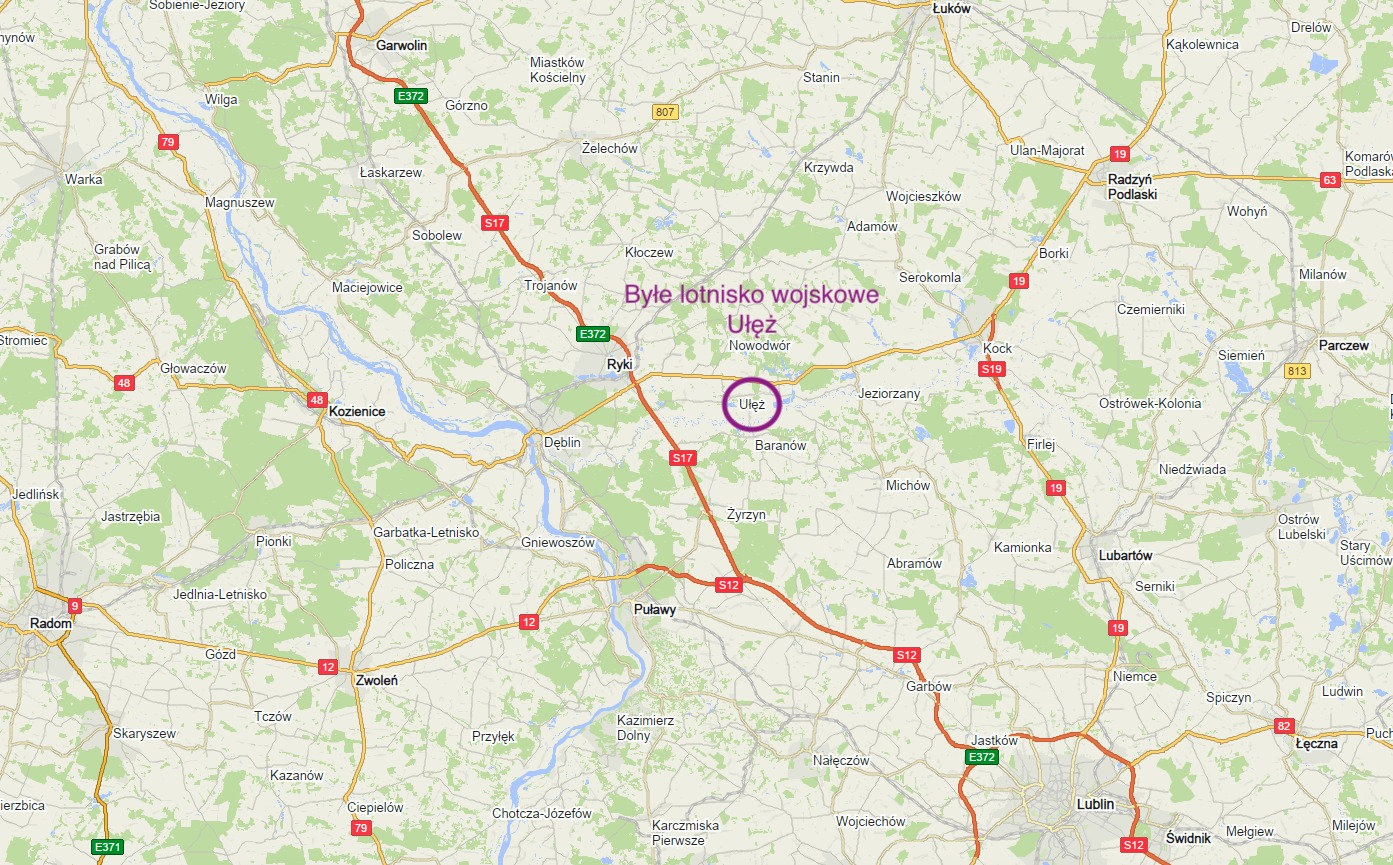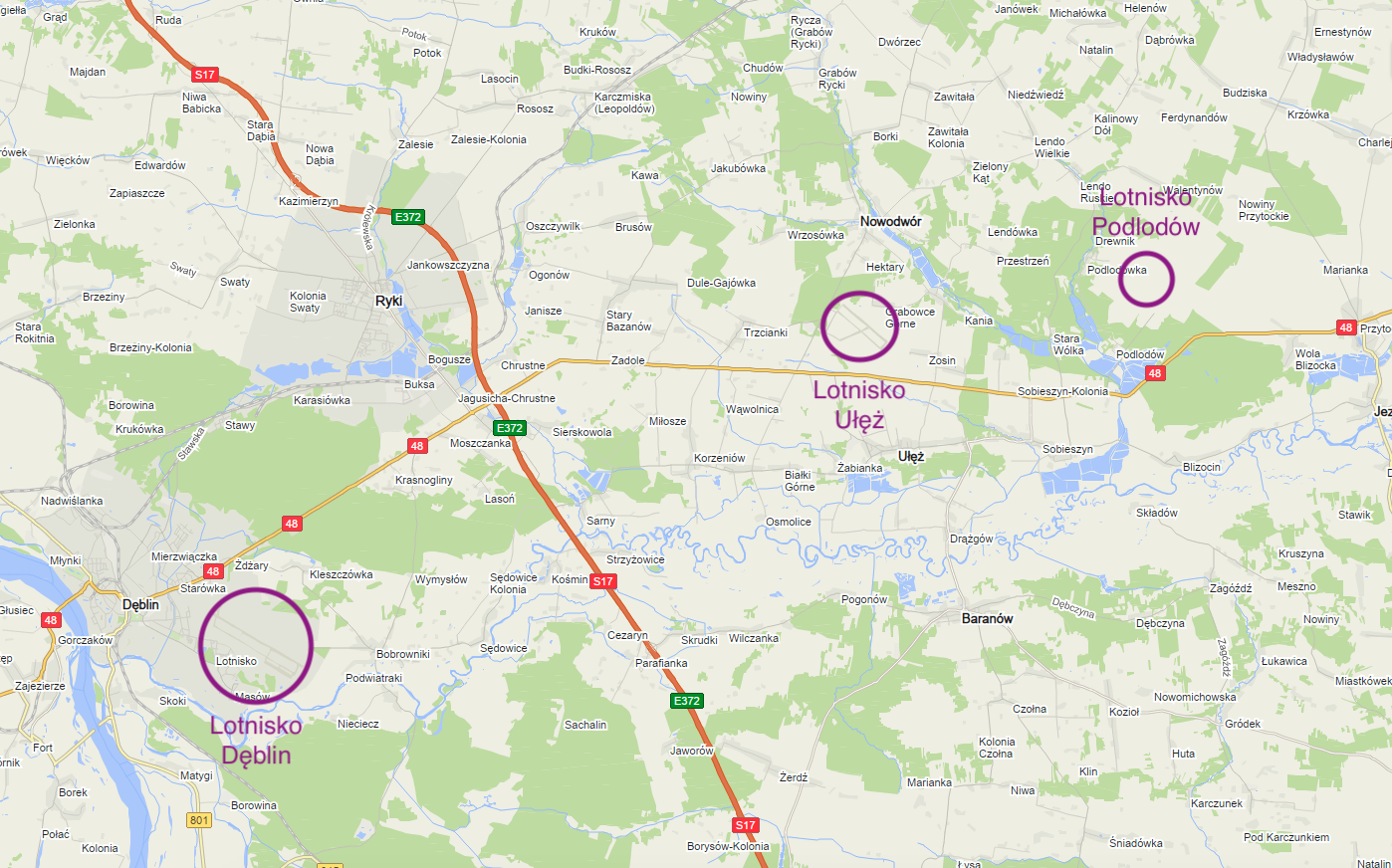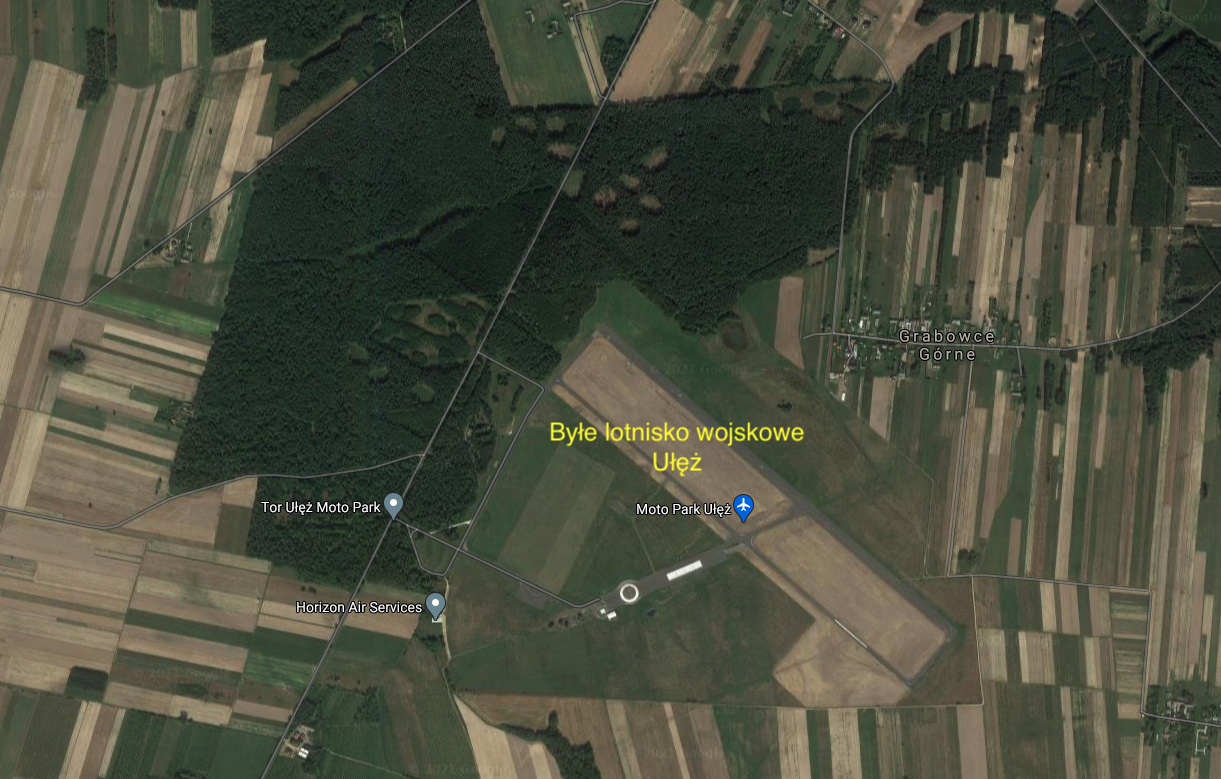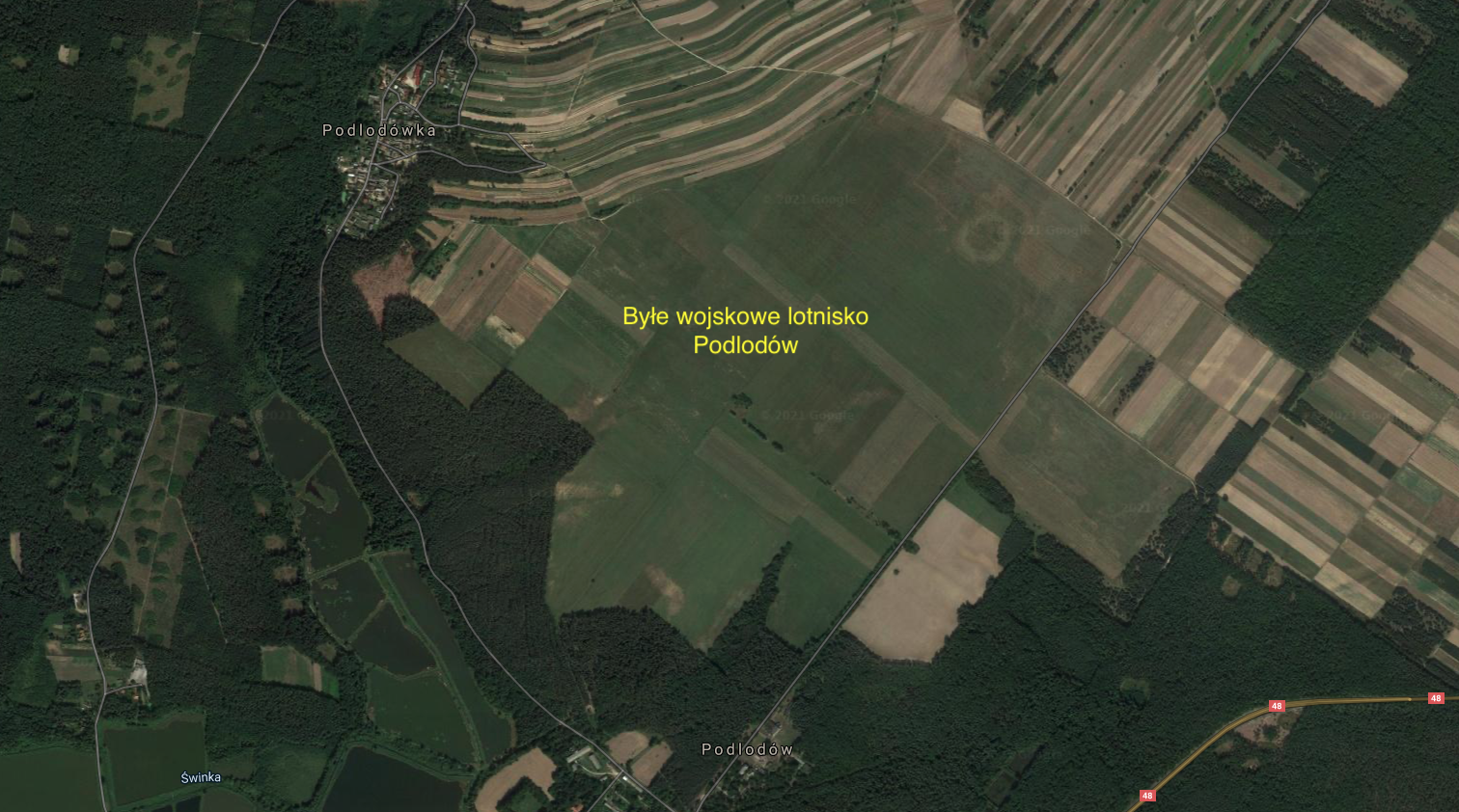Ułęż 2016-02-18
Lotniska Ułęż i Podlodów.
Lotnisko Ułęż. Współrzędne geograficzne: 51.619N 22.101E. Elewacja 172 m.
Ułęż.
Ułęż to miejscowość położona w Województwie Lubelskim (od 1975 roku), w Powiecie Ryckim, w Gminie Ułęż. Na terenie gminy leżą dwa były wojskowe lotniska. Pierwsze o nazwie Lotnisko Ułęż, położone na północ od Miejscowości Ułęż, obok drogi DK 48. Drugie lotnisko o nazwie Lotnisko Podlodów, położne jest we wschodniej części gminy, zaledwie 10 km od lotniska pierwszego. Z Ułęża do Dęblina jest około 20 km. Przy wjeździe do Ułęża od strony drogi krajowej Nr 48 znajduje się tablica upamiętniająca dwóch poległych pilotów: ppor. pil. Zbigniewa Dobrzańskiego i kpr. pil. Lecha Kaczmarka. Ponieśli oni śmierć podczas Wojny Obronnej w dniu 9 września 1939 roku, rażeni z broni pokładowej niemieckiego samolotu. W 1991 roku, Lotnisko Ułęż i Lotnisko Podlodów zostały przejęte przez AMW (Agencja Mienie Wojskowego) i nie musiały zachować lotniczego charakteru. Oba lotniska czekały na inwestorów i są do zagospodarowania.
Powierzchnia Gminy Ułęż to 84 km kwadratowe. Gmina liczy 3 637 mieszkańców, zamieszkujący 12 miejscowości. W 2016 roku, Miejscowość Ułęż liczyła 1 677 mieszkańców. Kod pocztowy miejscowości to 08-504. Początek stacjonarnych numerów telefonów to +48 81. Gmina Ułęż geograficznie leży na Wysoczyźnie Żelichowskiej i Pradoliny Wieprza, na tak zwanym Małym Mazowszu.
Przez Gminę Ułęż przebiega droga krajowa Nr 48; Tomaszów Mazowiecki – Dęblin – Kock oraz droga krajowa Nr 17; Warszawa – Lublin – Hrebenne. Wszystkie drogi na terenie gminy są w bardzo dobrym stanie. Gmina jest ceniona jako turystyczna. Wzmiankę o miejscowości Ułęż w swojej Kronice zamieścił Jan Długosz, jako „Ulanze Primum”, „Ulanze Secundum”. Najcenniejszym zabytkiem gminy jest pałac projektu Jana Kubickiego z XIX wieku, wzorowany na warszawskim Belwederze. Obecnie mieści się w nim urząd gminy. Atrakcją gminy jest Dąb Sobieskiego w Sobieszynie, datowany na 700 lat. Zabytkami są także: Kościół w Żabiance z 1745 roku, Kościół w Sobieszynie, Pałac w Sobieszynie oraz zespoły dworskie w Podlodowie i Sarnach. Mieszkańcy gminy utrzymują się głównie z rolnictwa. Na terenie gminy jest 1 054 gospodarstwa o łącznej powierzchni 4 609 ha. 72 % powierzchni gminy to pola uprawne. Lasy stanowią 23 % powierzchni, a zbiorniki wodne (w tym stawy – 150 ha) 7 % powierzchni. Ponad 50 % gospodarstw posiada dostęp do sieci wodociągowej. Na terenie gminy są: dwie szkoły podstawowe, jedno gimnazjum i dwie szkoły średnie (liceum ogólnokształcące i zespół szkół rolniczych).
W 1955 roku, niemal całą miejscowość Ułęż strawił pożar. Jedną z przyczyn tak dużych start była ciasna zabudowa miejscowości. Był to trzeci duży pożar w historii miejscowości.
Germańcy pozostawili po sobie pamiątki w postaci wielu miejsc zbrodni. Pierwszą masową egzekucję wykonali w 1941 roku, na terenie Lotniska Ułęż, mordując ponad 20 osób z romskiego (cygańskiego) taboru, pod zarzutem kradzieży ryb z okolicznych stawów. Rok później dokonali podobnej zbrodni mordując kolejne ponad 20 osób; mężczyzn, kobiet i dzieci.
Lotniska w tej części Polski należały do tak zwanego przedwojennego węzła Dęblińskiego. Były to lotniska w pobliżu miejscowości: Borowej, Gołębiu, Podlodowie, Ułężu i Zajezierzu. Nieodległymi lotniskami był; Nosów koło Białej Podlaskiej (P.23 Karaś), Marynin koła Radzymina (P.23 Karaś), Łuszczów, Motycz, Strzelce koło Hrubieszowa, Jabłonna koło Lublina. Lotniska te zostały wyznaczone przez Wojsko Polskie (Główny Inspektorat Sił Zbrojnych oraz Sztab Generalny) z początkiem 30-lat XX wieku. Pełniły one role lotnisk polowych, zapasowych, zasadzkowych lub awaryjnych. Zwykle umieszczano je w pobliżu majątków ziemskich, gdyż to gwarantowało: dobre warunki socjalne dla mechaników, pilotów i kadry oficerskiej. Okoliczne sady dawały łatwość maskowania samolotów. Łąki i pastwiska była wystarczającymi drogami startowymi. Kuźnia była polowym warsztatem, a stajnia z końmi gwarantowała pewny transport.
Lotnisko Ułęż.
Lotnisko Ułęż należało do lotnisk priorytetowych. W planach Wojska Polskiego miało pełnić funkcje lotniska zapasowego dla Dęblina z możliwością kształcenia podchorążych. W związku z tym jego infrastruktura była rozbudowana. Lotnisko zostało oddane do użytku w 1937 roku. Należało do nowoczesnych lotnisk szkolnych. Miało dwa murowano-stalowe z oszkleniem hangary, koszary, kwatery dla kadry, kasyno, magazyny, skład paliw, wartownie i inne. Wśród nich było kilka obiektów murowanych. Wszystkie one były jednokondygnacyjne. Jednak większość budynków była drewniana w postaci baraków. Większość budynków umieszczono w pobliskim lesie i śladami po nich są już tylko polany.
W okresie od 1937 roku do 1939 roku, Lotnisko Ułęż wykorzystano do szkolenia lotników ze szkoły z Dęblina. Wiosną 1939 roku, do Ułęża przeniesiono z Grudziądza Wyższą Szkołę Pilotażu, której komendantem był kpt pilot Stanisław Brzezina. Z chwilą mobilizacji, na lotnisku bazował X. Dywizjon Bombowy, prze-numerowany na 210. Dywizjon Bombowy (211 i 212 Eskadra). Jednostka miała w składzie 18 bombowców typu PZL-37 Łoś oraz jeden transportowy Fokker F-VII i kilka samolotów łącznikowych RWD-8.
Po ataku armii niemieckiej na Rzeczpospolitą Polskę lotnisko było wykorzystywane przez lotnictwo Luftwaffe oraz jako miejsce zagłady ludności cywilnej. W latach okupacji, niemcy nadali niektórym budynkom nazwy własne, jak na przykład Posen (Poznań), czy Graudenz (Grudziądz), malując na nich herby tych miast.
Latem 1944 roku, kiedy zbliżał się wschodni front, niemcy wycofali się, wysadzając w powietrze niemal wszystkie obiekty. Zniszczyli także betonowa drogę startową, niszcząc ją bombami.
Z początkiem 1945 roku, rosjanie przekazali lotnisko stronie Polskiej, jako obiekt bardzo zniszczony i nie nadający się dla nich do wykorzystania. Lotnisko Ułęż przejęła Dęblińska Szkoła Pilotów, a następnie Radomska Szkoła (OSL-Radom). Lotnisko odbudowano do stanu używalności, ale nigdy nie osiągnęło poziomu z czasu Drugiej Rzeczypospolitej Polskiej. Skupiono się głównie na rozbudowie pola wzlotów, odbudowując betonową drogę startową i budując drogi kołowania i PPS (Płaszczyzny Postoju Samolotów). Lotnisko otrzymało status lotniska polowego.
W 1958 roku, na lotnisku bazowała 24. Eskadra Pilotów Rezerwy. W 60-latach, podczas kolejnego remontu pola wzlotów nawierzchnię pokryto asfalto-betonem i ten sposób konserwacji utrzymano do chwili, kiedy wojsko opuściło ten teren. Główna droga startowa (RWY) otrzymała wówczas wymiary 1 370 m x 30 m. Z tej drogi swobodnie korzystały samoloty typu Lim-1/2/5/6. W 70-latach, na lotnisku bazowała 24. Szkolna Eskadra Śmigłowców, użytkująca śmigłowce Mi-2. W tym to okresie dowódcą eskadry był kpt pilot Niemiec i wówczas szkolono także pilotów z krajów arabskich.
W 1991 roku, Lotnisko Ułęż zostało przejęte przez Agencję Mienia Wojskowego i czekało na zagospodarowanie. Obecnie (2017 rok) na polu wzlotów jest tor samochodowo-motocyklowy prowadzony przez szkołę doskonalenia techniki jazdy. Odbywają się tutaj imprezy motorowe. Teraz Lotnisko Ułęż ma status lądowiska i za każdym razem trzeba uzyskać zgodę zarządcy. Lotnisko ma współrzędne N51°37’08.8" E22°06’05.1". Elewacja 560 ft. RWY o nawierzchni asfalto-beton na kierunku 131/311, o wymiarach 1 400 m x 30 m. Lotnisko zamienione na tor wyścigów samochodowych. Na drodze startowej i drogach kołowania mogą znajdować się przeszkody wyznaczające trasę slalomu motocyklowego lub samochodowego.
Lotnisko Podlodów.
Miejscowość nazywa się Podlodów, ale na niektórych mapach można spotkać nazwę Podlodówka. Pierwsze wzmianki o miejscowości Podlodów pochodzą 1569 roku, i informują o folwarku i wsi. Właścicielem był Grzegorz Podlodowski. W miejscowości Podlodów istnieje dwór, będący dobrym zapleczem dla lotniska polowego. Zespół dworski pochodzi z pierwszej połowy XIX wieku. Pierwsze budowle w tym miejscu powstały już w XVII wieku. Dwór był rozbudowany w drugiej połowie XIX wieku i na początku XX wieku. Jednocześnie, w pierwszej połowie XIX wieku założono park. Systematyczny rozwój majątku zakończył się w 1939 roku. Później była tylko degradacja. W 1944 roku, komuniści pozbawili własności prawowitych właścicieli. Dobra majątku Podlodów, liczące 601 816 ha zostały włączone w Państwowe Gospodarstwo Rybackie z siedzibą w Lublinie, oddział w Kocku z siedzibą w Podlodowie. Po latach zostało ono przekształcone w Państwowe Gospodarstwo Rybackie sp z o o Kock. W 1973 roku, zespół dworski został wpisany do rejestru zabytków, potwierdzone kolejnymi wpisami w 1985 roku i w 1996 roku. Jednym z zabytkowych obiektów jest tak zwana rządcówka, która została zbudowana około 1900 roku. Obecnie jest to dom mieszkalny i sklep.
Lotnisko zostało założone w połowie 30-lat, jako lotnisko charakterem zbliżone do zapasowego (pomocniczego). Pole wzlotów nie było idealnie równe, ale wystarczające i bardzo duże. Układ pola wzlotów nie dawał sposobności do dobrego maskowania samolotów, gdyż było otoczone polami uprawnymi na których w 1939 roku, uprawiano ziemniaki.
W dniu 31 sierpniu 1939 roku, na lotnisku stacjonował 215. Dywizjon Bombowy (216 i 217 Eskadra), poprzednio oznaczony XV. Dywizjon Bombowy, przebazowany z Lotniska Okęcie. Dywizjon miał na wyposażeniu samoloty PZL P.37 Łoś (około 18 sztuk) oraz kilka samolotów RWD-8 i jeden transportowy Fokker F-VII. Obie Eskadry wzięły udział w Wojnie Obronnej 1939 roku. W związku ze wspomnianymi powyżej zagonami ziemniaków, żołnierze i ludność cywilna wykopała ziemniaki, pole wyrównano, położono darń i tak zrobiono drogi kołowania, aby samoloty ustawić pod drzewami i je zamaskować.
Podczas okupacji, niemcy, na polu wzlotów wykonali betonową drogę startową. Kilkanaście lat temu można było natrafić na fragmenty betonu, który był nawierzchnią RWY. Przypuszczalnie były dwie drogi startowe umieszczone na planie krzyża.
Od jesieni 1945 roku, na Lotnisku w Ułężu i Podlodowie szkolono pilotów dla Ludowego Wojska Polskiego przy pomocy samolotów UT-2. Czasami na lotniskach bazowały samoloty Po-2.
W 1952 roku, sformowano 5. Eskadrę Pilotażu Podstawowego przy dęblińskiej OSL-4. Dowódcą był kpt pilot Kazimierz Ciepiela. Na początku 1953 roku, Oficerska Szkoła Lotnicza Nr 5 przeszła kolejną reorganizację, jednocześnie przechodząc na nowy etat nr 20/266. W związku z tym z dęblińskiej OSL-4 do radomskiej OSL-5, przekazano 5. Eskadrę Pilotażu Podstawowego. Równocześnie szkole przekazano Lotnisko Podlodów, które stało się miejscem stacjonowania Eskadry. Szkolenie pilotów prowadzono w oparciu o Polskie samoloty Junak-2.
W związku z przyjęciem przez Wojsko Polskie nowej techniki lotniczej, wymagającej rozbudowy systemu zaopatrzenia i infrastruktury lotnisk, dlatego w 1957 roku dokonano kolejnej reorganizacji. W lutym 1958 roku szkoła i eskadry w Podlodowie zostały rozformowane. Samo lotnisko przekazano pod dowództwo dęblińskiej OSL-4. Kolejno dowódcami 5. Eskadrę Pilotażu Podstawowego byli, kapitanowie piloci: Kazimierz Ciepiela, Andrzej Adamczuk (1953-1954), Stanisław (1954-1957), Piekara (1957-1958). Wielu żołnierzy byli żołnierzami służby zasadniczej. Szkolonymi pilotami byli podchorążowie, którzy mieli za sobą choćby szkolenie spadochronowe. Kadra zawodowa składała się z oficerów i podoficerów. Oprócz dowódcy najważniejszy był sekretarz POP (podstawowa organizacji partyjnej PZPR) i instruktor ZMP (związek młodzieży polskiej). Dopiero dalej byli: szef łączności, instruktor WF (wychowania fizycznego), szefowie eskadr, kancelista, maszynistka (pracownik cywilny), instruktor spadochronowy, układacz spadochronów, nawigator eskadry, dowódcy kluczy, piloci instruktorzy, technicy kluczy, (starsi) mechanicy lotniczy, mechanicy silnikowi, mechanicy przyrządów pokładowych, mechanicy instalacji elektrycznej, mechanicy uzbrojenia lotniczego, majster radiowy, dowódcy i szefowie kompanii, lekarz, felczer, podoficer gospodarczy, szef MPS, inżynier lub technik osprzętu, inżynier lub technik uzbrojenia, kucharze, wartownicy.
Przez cały czas istnienia 5. Eskadry Pilotażu Podstawowego użytkowano samoloty szkolno-treningowe Junak-2 zastąpione TS-9 Junak-3. Podstawową różnicą między tymi samolotami był układ podwozia. TS-9 Junak-3 posiadał przednie koło, a nie kółko ogonowe.
Obecnie nie ma po drodze startowej śladu. W 1991 roku, Lotnisko Podlodów zostało przejęte przez AMW i nadal czeka na zagospodarowanie. Pole wzlotu służy jako użytki rolne dzierżawione przez okolicznych rolników.
Współrzędne 51 36 49 N 22 11 16 E. Elewacja 165 m npm. Obecnie pole wzlotów jest wielką łąką.
Opracował Karol Placha Hetman




